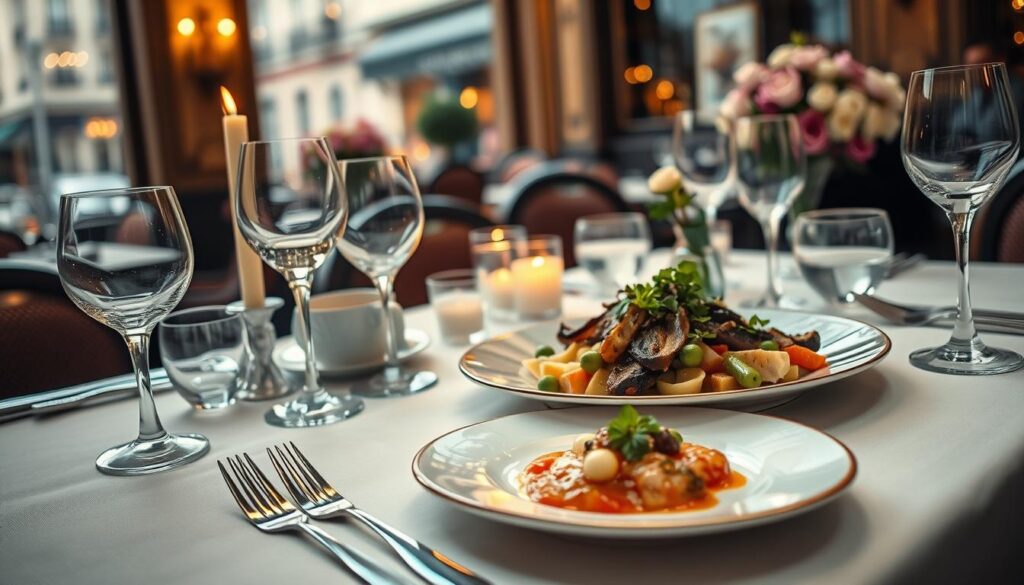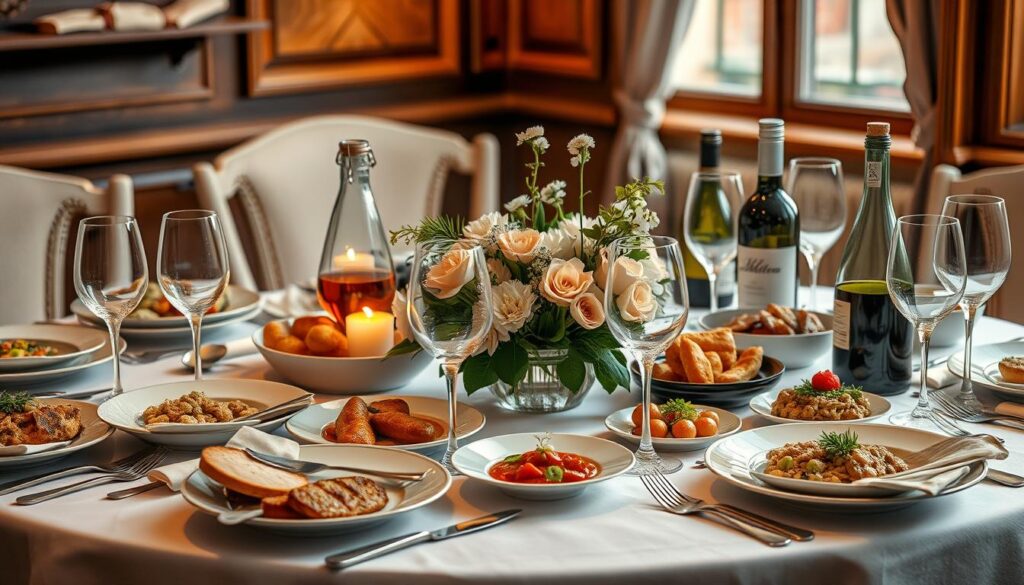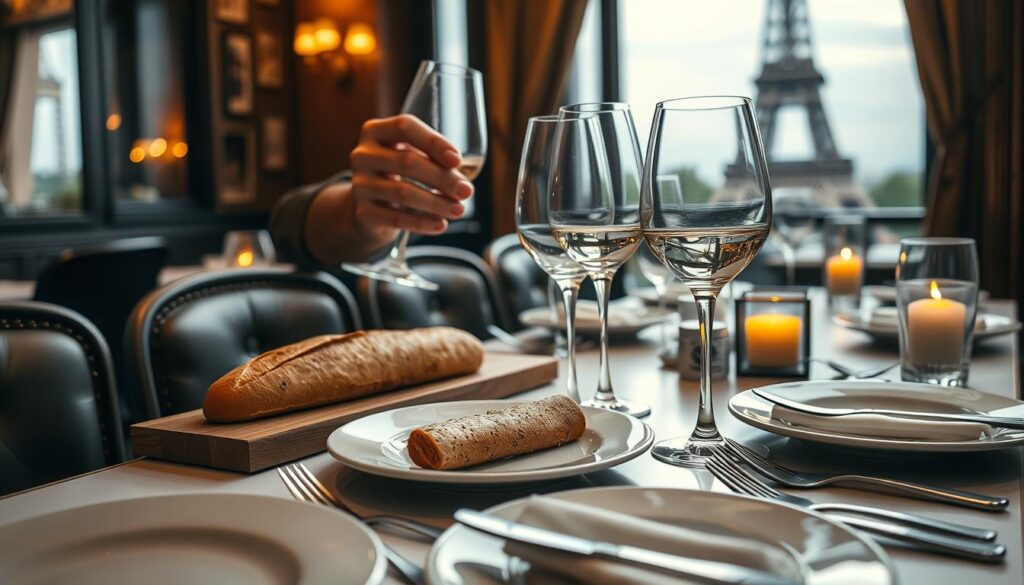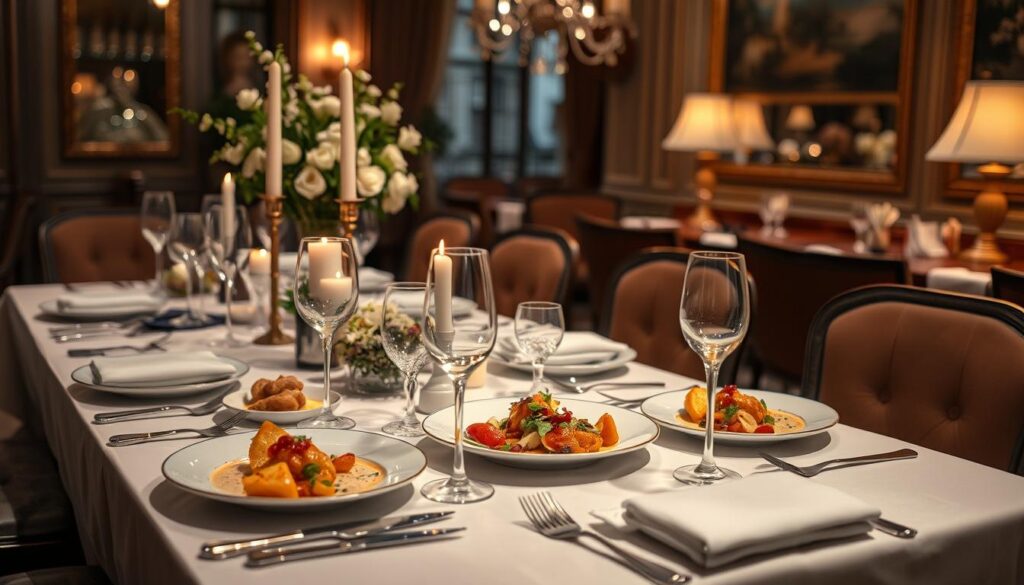Ever wondered what makes Parisian dining etiquette special? As an American in France, learning the local dining norms is key. It’s not just about using the right fork. It’s about understanding a world of silent rules.
In Paris, dining is like a silent dance. It can make your meals magical. You’ll learn to avoid mistakes like asking for a doggy bag or tipping wrong. It’s about diving into a tradition that values the art of dining.
Before you enjoy Paris’s famous bistros, let me show you the way. We’ll explore the cultural dining elegance of the City of Light.
In this post, you'll find...
Key Takeaways
- Recognize the difference between American and French dining etiquette to navigate Parisian restaurants seamlessly.
- Appreciate the infrequency of table service in France compared to the U.S., seeking a more relaxed dining experience.
- Embrace the proper sequence of drink service and understand the significance of cheers rituals in French culture.
- Learn how to gracefully manage bread and understand its actual role within a French meal.
- Be aware of the French perspective on leftovers, doggy bags, and how to handle portions.
- Understand the subtleties of tipping in France, contrasting American expectations.
- Prepare for the leisurely pace of a French meal and familiarize yourself with typical dining hours and practices.
The Distinctive Charm of Parisian Dining Culture
Parisian dining culture is known for its mix of tradition and casual elegance. It’s a city that leads in international dining customs. Here, diners find a place where freedom and order blend well.
In cafes and bistros, you pick your own seat. Sometimes, you’ll find a charming spot with a view of Paris’s busy streets.
When dining out in Paris, formal dining practices are clear. It starts with an apéritif to prepare your taste buds. Then, a carefully planned menu follows, ending with a digestif or espresso. This way, each dish is enjoyed fully, showing respect for French cuisine.
Etiquette tips for dining out in Paris include being on time but not too early. Arriving a bit late is common for formal meals. It helps manage the meal’s flow. But, always finish your meal to show you enjoyed it and to honor the host’s effort.
Following these rules makes your dining in Paris better. It connects you more with French dining traditions. Knowing how to handle different cheeses is also important. It shows you respect the local dining ways.
Dining in Paris is more than just eating. It’s a chance to join a long-standing cultural tradition. Visiting places like the Louvre Museum or the French Film Festival adds to the experience. It connects you with France’s rich culture and art.
Exploring Parisian dining culture is rewarding. It not only feeds your taste buds but also enriches your soul. By understanding and respecting these customs, you’ll truly enjoy dining out in Paris.
Dining Etiquette in Paris: Navigating the Unspoken Rules
Traveling to Paris means learning about local dining etiquette. It’s not just about using the right utensils. It’s also about understanding cultural norms and traditions that make French dining special.
Greetings and Seating Customs in Parisian Restaurants
In Paris, saying hello is key. Use “Bonjour” (before 6 PM) or “Bonsoir” (after 6 PM) with eye contact. This shows respect and sets a friendly tone with the staff.
Choosing your seat is easier in casual places like cafes. But in formal restaurants, wait to be seated. Tables are close together in Paris, making dining more intimate and reflecting the city’s culture.
The Ritual of Ordering and Meal Progression
Ordering food in Paris is a bit different. Meals come in courses, starting with the entrée, then the plat, and sometimes ending with cheese or dessert. It’s not common to call out for a waiter. A gentle gesture or eye contact works best.
Meals in Paris are enjoyed slowly. People are encouraged to savor each bite and enjoy the company. This makes dining a special, almost ceremonial experience in France.

Knowing when restaurants are open can improve your dining experience. Many close on Sundays and Mondays, and have shorter hours in late July and August. Dinner starts around 7:00 PM, later than in many places.
It’s polite to ask for the bill yourself. Waiting for the check can make guests feel rushed. Saying “L’addition, s’il vous plaît” shows respect for the dining experience and the restaurant’s time.
Exploring Paris’s dining etiquette lets you enjoy great meals and appreciate French culture more. It’s a chance to dive into the rich traditions of French dining.
The Art of the French Meal: Drink Etiquette and Pairings
Diving into French dining traditions often begins with a deep respect for drink etiquette and pairing. These aspects are key to formal dining practices in France. They make the meal more than just food; they respect the culture deeply.

In France, meals start with an apéritif, a drink before dinner. It’s a cultural tradition and a way to awaken the palate. You might have a Champagne or a Kir Royal, depending on the time and place.
Wine selection is crucial during the meal. Each wine is chosen to match the dishes perfectly. This shows the careful attention to detail in French cooking.
A light white wine might go with the first course, and a stronger red with the main dish. The French love the way wine and food come together. They often ask the sommelier for wine recommendations, which adds to the dining experience.
After the meal, regional cheeses are served, with wines that match their flavors. The meal ends with a dessert and a digestif, like Cognac or Armagnac. This completes the dining experience beautifully.
These practices are not just formalities; they are essential to enjoying food and company in France. They show that food is seen as an art form, in every sip and bite. Eating in France is a tradition that values both taste and togetherness.
To learn more about budget travel and dining, check out this guide. It offers tips on enjoying meals without spending too much.
The focus on drink etiquette and the way meals are structured shows the heart of French dining traditions. These customs create a space where both food and company are cherished, capturing the essence of French culture.
Tips for Toasting and Bread Etiquette in France
Exploring France’s culinary scene means learning about dining etiquette in Paris. Knowing the etiquette tips for dining out makes your experience better. It also shows you respect French culture.
Proper Cheers Etiquette to Avoid Years of Bad Luck
In France, toasting is a big deal, called “trinquer.” When you toast, make sure to look at everyone at the table. Not doing so might bring bad luck in relationships for seven years. This shows how important connection and respect are in French dining.
Also, don’t cross your arms while toasting. It’s believed to bring bad luck too.
Understanding the Role of Bread at the French Dining Table
Bread is more than just a starter in France. It’s a key part of the meal. Place your bread on the table, not on a bread plate. Use it to push food onto your fork or soak up sauce.
Never put your bread upside down on the table. It’s thought to bring bad luck.
Statistics show that 43% of French people spend over 45 minutes on lunch. This highlights the importance of mealtime, where bread is key. Here’s how bread consumption compares in France with other countries:
| Country | Average Daily Bread Consumption | Types of Bread Preferred | Meal Occasions |
|---|---|---|---|
| France | High | Baguette, Brioche, Ficelle | All meals (incl. breaks) |
| USA | Moderate | Sliced bread, Bagel | Mainly breakfast |
| Italy | Low | Ciabatta, Focaccia | Meals excluding breakfast |
| Germany | High | Rye bread, Pumpernickel | Primarily breakfast and dinner |

Learning these Parisian dining etiquette and table manners in France enriches your cultural understanding. It also lets you join in French dining traditions with respect and knowledge.
Experiencing the Course: Savoring Meals and Handling Leftovers
Exploring Paris’s culinary scene reveals a lot about French dining. The slow pace and respect for mealtime stand out. This is different from the fast pace of dining in other places.
Meals in Paris are a chance to enjoy each dish slowly. You can appreciate the company and the atmosphere of Parisian restaurants. This shows how dining in France is about pleasure and socializing, not just eating.
The Pace of French Dining: A Leisurely Endeavour
In Paris, meals take hours, making time stand still. The way servers treat diners shows respect for their time. This makes dining a joyful experience, fitting with the French belief that good food deserves time.
Portion Sizes and the Rarity of Doggy Bags
Parisian dining is all about the right portion size. This lets diners enjoy conversation without feeling too full. Taking leftovers home is rare, as meals are meant to be finished at the table.
Here’s a look at French dining habits through numbers:
| % of French Households | Meal Pattern |
|---|---|
| 87% | Long lunches with a full menu |
| 71% | Smaller, communal dinners |
| 91% | Strict meal times, no snacking |
These numbers show how dining is a big part of French culture. Meals are a time to come together and celebrate. They help keep French society strong.
French dining is truly special. It’s a chance to slow down and enjoy life. Every meal is a celebration of French culture.

Whether it’s a croissant at a café or dinner by the Seine, dining in Paris is key. It’s not just about the food but how you enjoy it. Let French traditions guide your dining experience, one delicious meal at a time.
Conclusion
My exploration of cultural dining norms in Paris has ended, leaving me with deep respect for French dining etiquette. The way bread is served, not as a starter but as a tool to enhance a dish, shows the care in every detail. Meals here are a slow, beautiful dance, not just about eating but a cherished tradition.
Dining in Paris means spending 2.5 to 3 hours for dinner or 1.5 hours for lunch. This slow pace lets me fully enjoy the French way of dining. I’ve learned not to ask for food changes and how to toast correctly to avoid bad luck. Whether at a fancy restaurant or a casual spot, knowing the local etiquette makes every meal special.
Discovering local customs and participating in French traditions has taught me a lot. Finishing my food and respecting meal times shows the importance of manners. Parisian dining etiquette has not only enriched my food journey but also connected me to France’s love for good food and company. This experience will stay with me, reminding me of the value of fine food and friendship, not just in Paris but everywhere.
FAQ
What should I do upon entering a Parisian restaurant?
Say “Bonjour” or “Bonsoir” when you enter. Make eye contact with the staff. In casual places, pick your own table unless it’s busy.
How should I get a server’s attention in France?
Catch their eye and wave softly. Avoid shouting or making loud gestures. It’s seen as rude.
Is it common to ask for a doggy bag in Paris?
Asking for a doggy bag is rare. It might surprise the staff. In France, meals are smaller, and you’re expected to finish it.
What is the typical sequence of a French dining experience?
Start with an apéritif to get hungry. Then, enjoy courses from starters to main dishes. Wine is served in between. Finish with a digestif or coffee.
How are drink pairings and ordering handled?
Drink pairings are key in French dining. Staff suggest wines and drinks for each meal part. Orders are taken one course at a time.
How is bread served in France compared to the U.S.?
Bread isn’t served with butter as a starter. Enjoy it during or at the end of your meal. It’s part of the meal, not just a prelude.
What is the proper way to “cheers” in France?
When toasting, clink glasses and look at the person you’re toasting with. Don’t cross your arms while cheering.
Are French dining experiences typically fast or slow?
French dining is slow and relaxed. Enjoy your meal and company without feeling rushed.
Hi, I’m Tiana – founder of and author here at Where Tiana Travels. I’m a 20-something with a love for all things travel, photography, and food. I have been living abroad for the past 5 years and solo traveling the globe in my free time. I created this blog to share my travel stories and inspire other women to go out and see the world. Read more about me here!

